Business Analysis Report: Agile Methods in Business Analysis
VerifiedAdded on 2023/04/06
|12
|2988
|254
Report
AI Summary
This report provides a comprehensive analysis of agile methods in contemporary business systems analysis, focusing on their impact and implications. It begins with an abstract highlighting the increasing adoption of agile methodologies to improve project quality and customer satisfaction, replacing traditional waterfall models. The research methodology involves the use of both academic and non-academic sources to identify and analyze trends. The report details agile methods, emphasizing their iterative and incremental nature, and highlights their attributes such as adaptive planning and flexible reactions to change. It explores the impact of agile methods on business requirements, outlining advantages like ease of adoption, skilled workforce development, and increased customer satisfaction. The report discusses system requirements for adopting agile methods, including staff knowledge and training, and concludes with a reflection on the identified trend, emphasizing benefits such as reduced risks and faster return on investment, making this a valuable resource for students studying business analysis.

Business Analysis
name of student:
name of college:
authors note:
Running head: BUSINESS ANALYSIS
name of student:
name of college:
authors note:
Running head: BUSINESS ANALYSIS
Paraphrase This Document
Need a fresh take? Get an instant paraphrase of this document with our AI Paraphraser
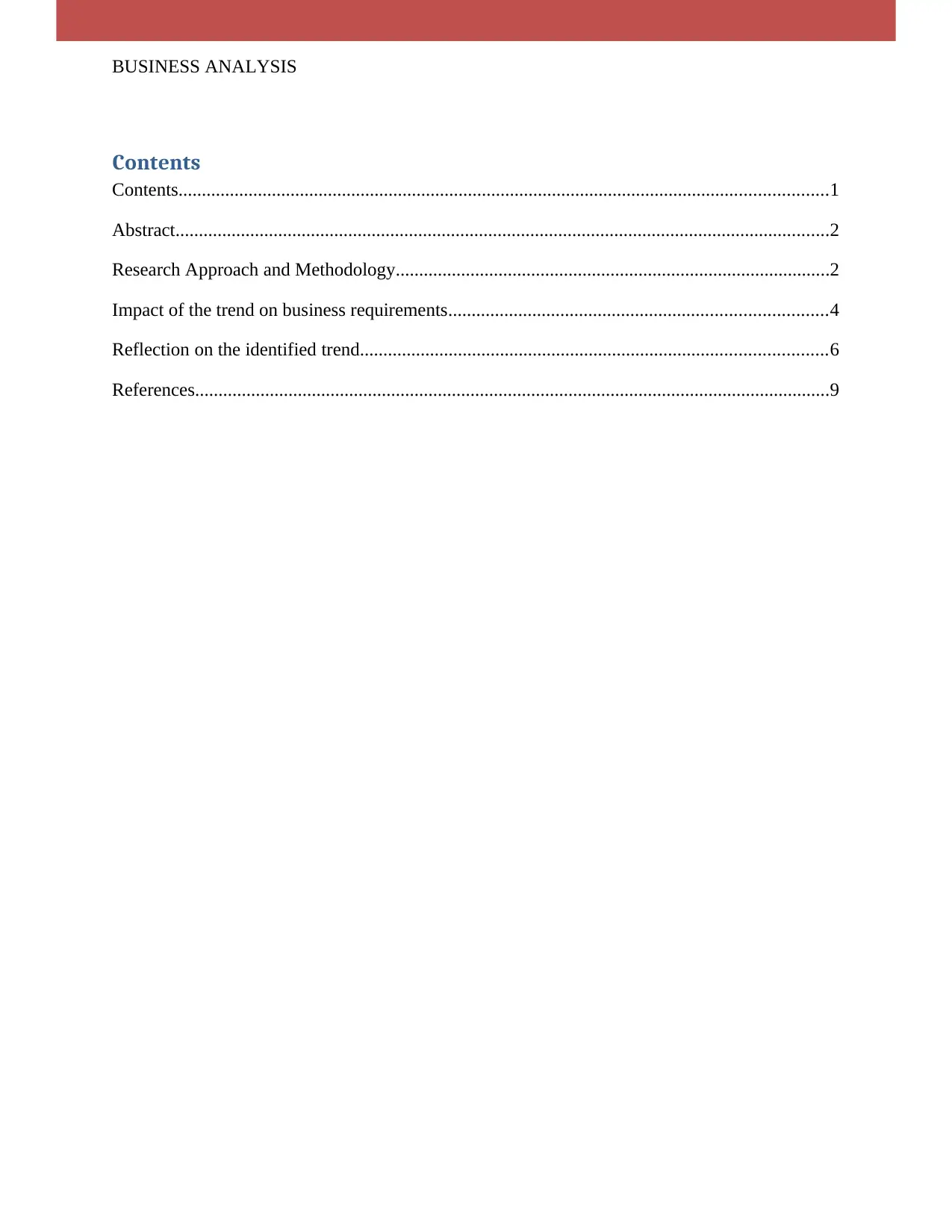
BUSINESS ANALYSIS
Contents
Contents...........................................................................................................................................1
Abstract............................................................................................................................................2
Research Approach and Methodology.............................................................................................2
Impact of the trend on business requirements.................................................................................4
Reflection on the identified trend....................................................................................................6
References........................................................................................................................................9
Contents
Contents...........................................................................................................................................1
Abstract............................................................................................................................................2
Research Approach and Methodology.............................................................................................2
Impact of the trend on business requirements.................................................................................4
Reflection on the identified trend....................................................................................................6
References........................................................................................................................................9
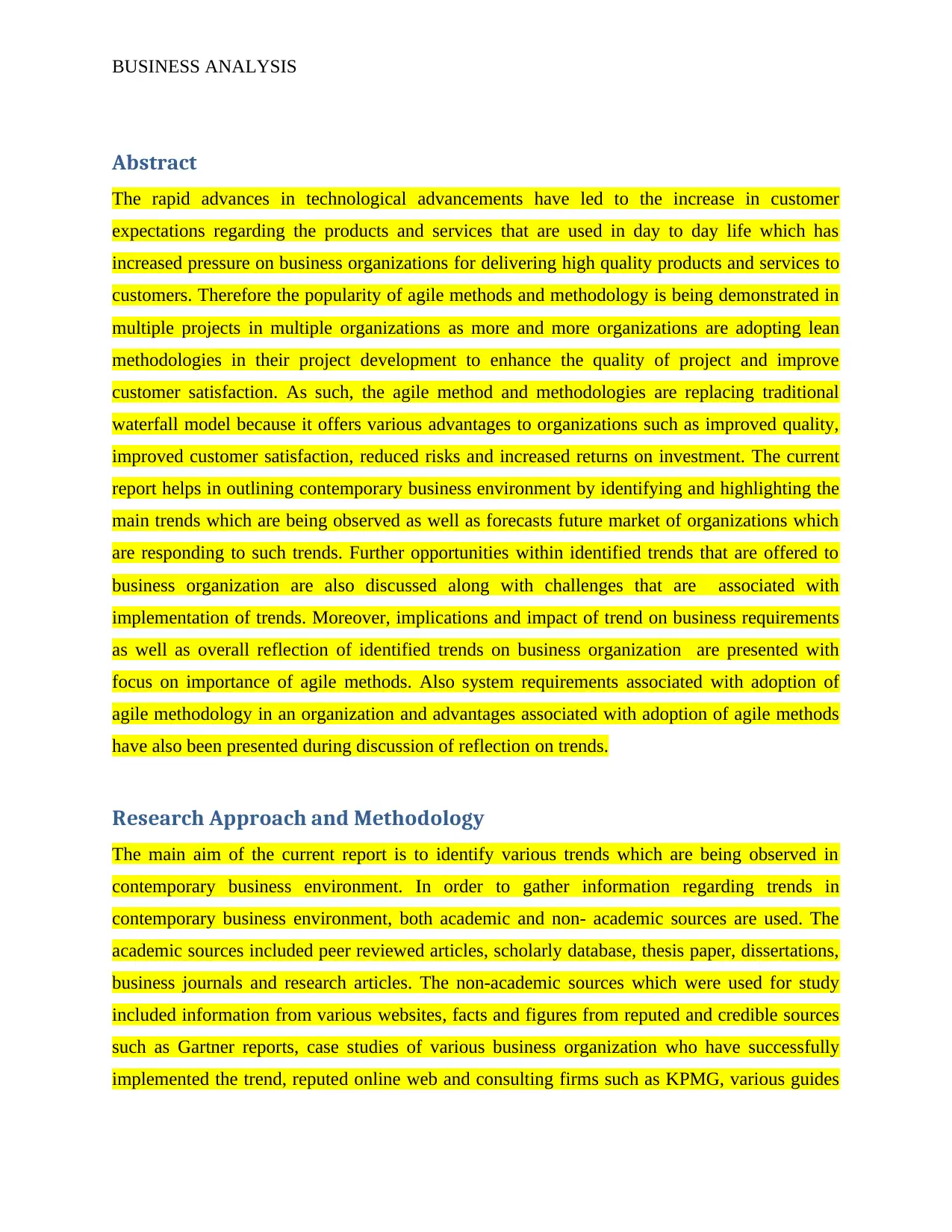
BUSINESS ANALYSIS
Abstract
The rapid advances in technological advancements have led to the increase in customer
expectations regarding the products and services that are used in day to day life which has
increased pressure on business organizations for delivering high quality products and services to
customers. Therefore the popularity of agile methods and methodology is being demonstrated in
multiple projects in multiple organizations as more and more organizations are adopting lean
methodologies in their project development to enhance the quality of project and improve
customer satisfaction. As such, the agile method and methodologies are replacing traditional
waterfall model because it offers various advantages to organizations such as improved quality,
improved customer satisfaction, reduced risks and increased returns on investment. The current
report helps in outlining contemporary business environment by identifying and highlighting the
main trends which are being observed as well as forecasts future market of organizations which
are responding to such trends. Further opportunities within identified trends that are offered to
business organization are also discussed along with challenges that are associated with
implementation of trends. Moreover, implications and impact of trend on business requirements
as well as overall reflection of identified trends on business organization are presented with
focus on importance of agile methods. Also system requirements associated with adoption of
agile methodology in an organization and advantages associated with adoption of agile methods
have also been presented during discussion of reflection on trends.
Research Approach and Methodology
The main aim of the current report is to identify various trends which are being observed in
contemporary business environment. In order to gather information regarding trends in
contemporary business environment, both academic and non- academic sources are used. The
academic sources included peer reviewed articles, scholarly database, thesis paper, dissertations,
business journals and research articles. The non-academic sources which were used for study
included information from various websites, facts and figures from reputed and credible sources
such as Gartner reports, case studies of various business organization who have successfully
implemented the trend, reputed online web and consulting firms such as KPMG, various guides
Abstract
The rapid advances in technological advancements have led to the increase in customer
expectations regarding the products and services that are used in day to day life which has
increased pressure on business organizations for delivering high quality products and services to
customers. Therefore the popularity of agile methods and methodology is being demonstrated in
multiple projects in multiple organizations as more and more organizations are adopting lean
methodologies in their project development to enhance the quality of project and improve
customer satisfaction. As such, the agile method and methodologies are replacing traditional
waterfall model because it offers various advantages to organizations such as improved quality,
improved customer satisfaction, reduced risks and increased returns on investment. The current
report helps in outlining contemporary business environment by identifying and highlighting the
main trends which are being observed as well as forecasts future market of organizations which
are responding to such trends. Further opportunities within identified trends that are offered to
business organization are also discussed along with challenges that are associated with
implementation of trends. Moreover, implications and impact of trend on business requirements
as well as overall reflection of identified trends on business organization are presented with
focus on importance of agile methods. Also system requirements associated with adoption of
agile methodology in an organization and advantages associated with adoption of agile methods
have also been presented during discussion of reflection on trends.
Research Approach and Methodology
The main aim of the current report is to identify various trends which are being observed in
contemporary business environment. In order to gather information regarding trends in
contemporary business environment, both academic and non- academic sources are used. The
academic sources included peer reviewed articles, scholarly database, thesis paper, dissertations,
business journals and research articles. The non-academic sources which were used for study
included information from various websites, facts and figures from reputed and credible sources
such as Gartner reports, case studies of various business organization who have successfully
implemented the trend, reputed online web and consulting firms such as KPMG, various guides
⊘ This is a preview!⊘
Do you want full access?
Subscribe today to unlock all pages.

Trusted by 1+ million students worldwide
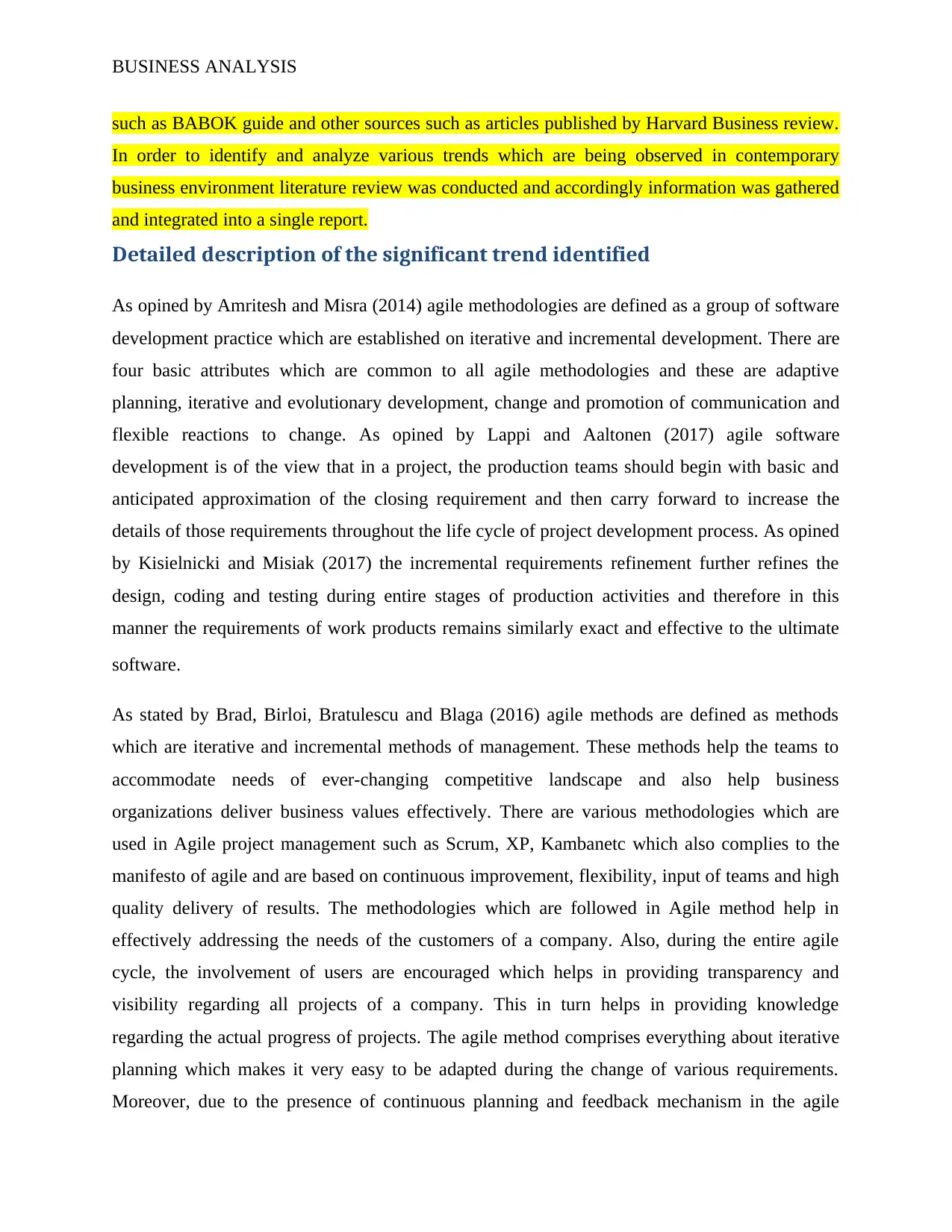
BUSINESS ANALYSIS
such as BABOK guide and other sources such as articles published by Harvard Business review.
In order to identify and analyze various trends which are being observed in contemporary
business environment literature review was conducted and accordingly information was gathered
and integrated into a single report.
Detailed description of the significant trend identified
As opined by Amritesh and Misra (2014) agile methodologies are defined as a group of software
development practice which are established on iterative and incremental development. There are
four basic attributes which are common to all agile methodologies and these are adaptive
planning, iterative and evolutionary development, change and promotion of communication and
flexible reactions to change. As opined by Lappi and Aaltonen (2017) agile software
development is of the view that in a project, the production teams should begin with basic and
anticipated approximation of the closing requirement and then carry forward to increase the
details of those requirements throughout the life cycle of project development process. As opined
by Kisielnicki and Misiak (2017) the incremental requirements refinement further refines the
design, coding and testing during entire stages of production activities and therefore in this
manner the requirements of work products remains similarly exact and effective to the ultimate
software.
As stated by Brad, Birloi, Bratulescu and Blaga (2016) agile methods are defined as methods
which are iterative and incremental methods of management. These methods help the teams to
accommodate needs of ever-changing competitive landscape and also help business
organizations deliver business values effectively. There are various methodologies which are
used in Agile project management such as Scrum, XP, Kambanetc which also complies to the
manifesto of agile and are based on continuous improvement, flexibility, input of teams and high
quality delivery of results. The methodologies which are followed in Agile method help in
effectively addressing the needs of the customers of a company. Also, during the entire agile
cycle, the involvement of users are encouraged which helps in providing transparency and
visibility regarding all projects of a company. This in turn helps in providing knowledge
regarding the actual progress of projects. The agile method comprises everything about iterative
planning which makes it very easy to be adapted during the change of various requirements.
Moreover, due to the presence of continuous planning and feedback mechanism in the agile
such as BABOK guide and other sources such as articles published by Harvard Business review.
In order to identify and analyze various trends which are being observed in contemporary
business environment literature review was conducted and accordingly information was gathered
and integrated into a single report.
Detailed description of the significant trend identified
As opined by Amritesh and Misra (2014) agile methodologies are defined as a group of software
development practice which are established on iterative and incremental development. There are
four basic attributes which are common to all agile methodologies and these are adaptive
planning, iterative and evolutionary development, change and promotion of communication and
flexible reactions to change. As opined by Lappi and Aaltonen (2017) agile software
development is of the view that in a project, the production teams should begin with basic and
anticipated approximation of the closing requirement and then carry forward to increase the
details of those requirements throughout the life cycle of project development process. As opined
by Kisielnicki and Misiak (2017) the incremental requirements refinement further refines the
design, coding and testing during entire stages of production activities and therefore in this
manner the requirements of work products remains similarly exact and effective to the ultimate
software.
As stated by Brad, Birloi, Bratulescu and Blaga (2016) agile methods are defined as methods
which are iterative and incremental methods of management. These methods help the teams to
accommodate needs of ever-changing competitive landscape and also help business
organizations deliver business values effectively. There are various methodologies which are
used in Agile project management such as Scrum, XP, Kambanetc which also complies to the
manifesto of agile and are based on continuous improvement, flexibility, input of teams and high
quality delivery of results. The methodologies which are followed in Agile method help in
effectively addressing the needs of the customers of a company. Also, during the entire agile
cycle, the involvement of users are encouraged which helps in providing transparency and
visibility regarding all projects of a company. This in turn helps in providing knowledge
regarding the actual progress of projects. The agile method comprises everything about iterative
planning which makes it very easy to be adapted during the change of various requirements.
Moreover, due to the presence of continuous planning and feedback mechanism in the agile
Paraphrase This Document
Need a fresh take? Get an instant paraphrase of this document with our AI Paraphraser
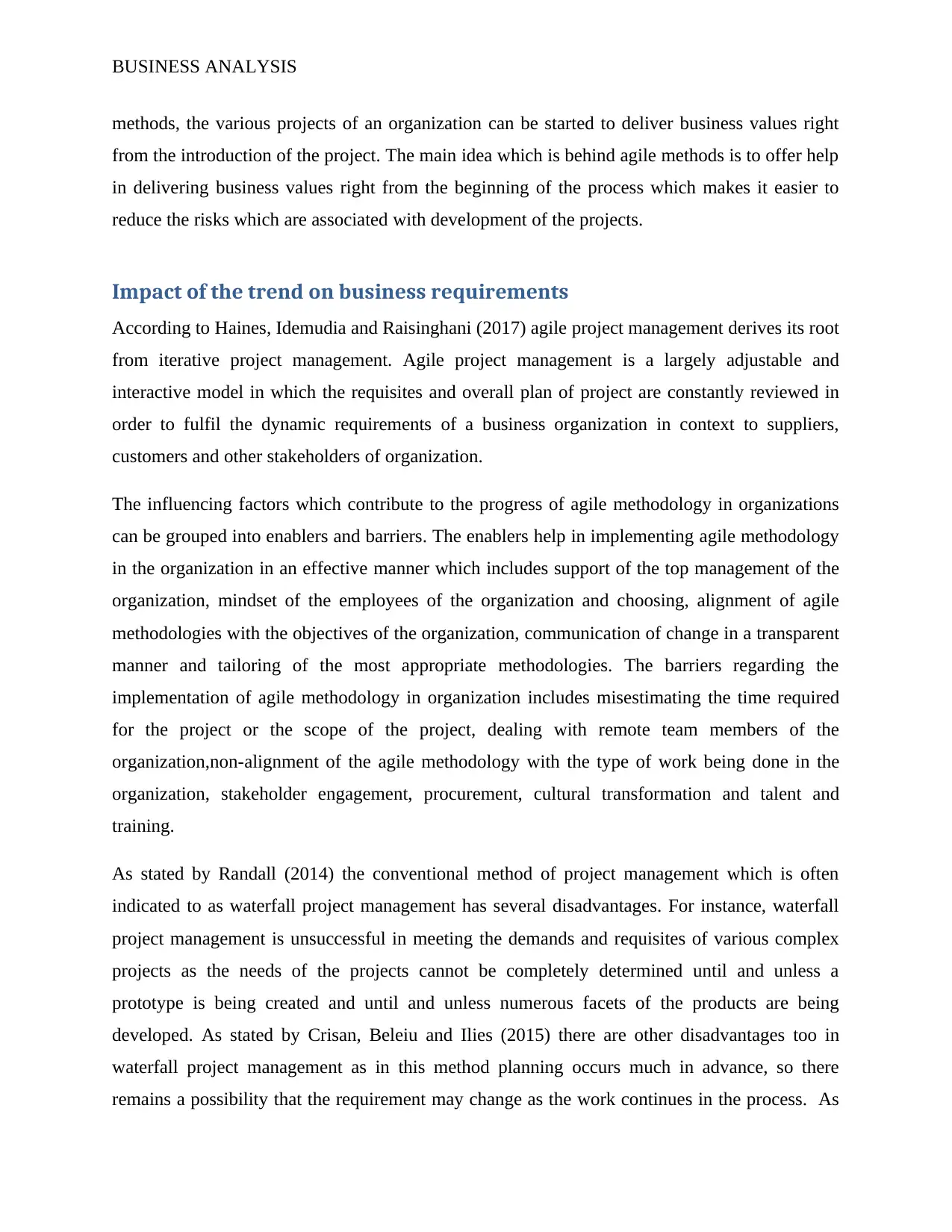
BUSINESS ANALYSIS
methods, the various projects of an organization can be started to deliver business values right
from the introduction of the project. The main idea which is behind agile methods is to offer help
in delivering business values right from the beginning of the process which makes it easier to
reduce the risks which are associated with development of the projects.
Impact of the trend on business requirements
According to Haines, Idemudia and Raisinghani (2017) agile project management derives its root
from iterative project management. Agile project management is a largely adjustable and
interactive model in which the requisites and overall plan of project are constantly reviewed in
order to fulfil the dynamic requirements of a business organization in context to suppliers,
customers and other stakeholders of organization.
The influencing factors which contribute to the progress of agile methodology in organizations
can be grouped into enablers and barriers. The enablers help in implementing agile methodology
in the organization in an effective manner which includes support of the top management of the
organization, mindset of the employees of the organization and choosing, alignment of agile
methodologies with the objectives of the organization, communication of change in a transparent
manner and tailoring of the most appropriate methodologies. The barriers regarding the
implementation of agile methodology in organization includes misestimating the time required
for the project or the scope of the project, dealing with remote team members of the
organization,non-alignment of the agile methodology with the type of work being done in the
organization, stakeholder engagement, procurement, cultural transformation and talent and
training.
As stated by Randall (2014) the conventional method of project management which is often
indicated to as waterfall project management has several disadvantages. For instance, waterfall
project management is unsuccessful in meeting the demands and requisites of various complex
projects as the needs of the projects cannot be completely determined until and unless a
prototype is being created and until and unless numerous facets of the products are being
developed. As stated by Crisan, Beleiu and Ilies (2015) there are other disadvantages too in
waterfall project management as in this method planning occurs much in advance, so there
remains a possibility that the requirement may change as the work continues in the process. As
methods, the various projects of an organization can be started to deliver business values right
from the introduction of the project. The main idea which is behind agile methods is to offer help
in delivering business values right from the beginning of the process which makes it easier to
reduce the risks which are associated with development of the projects.
Impact of the trend on business requirements
According to Haines, Idemudia and Raisinghani (2017) agile project management derives its root
from iterative project management. Agile project management is a largely adjustable and
interactive model in which the requisites and overall plan of project are constantly reviewed in
order to fulfil the dynamic requirements of a business organization in context to suppliers,
customers and other stakeholders of organization.
The influencing factors which contribute to the progress of agile methodology in organizations
can be grouped into enablers and barriers. The enablers help in implementing agile methodology
in the organization in an effective manner which includes support of the top management of the
organization, mindset of the employees of the organization and choosing, alignment of agile
methodologies with the objectives of the organization, communication of change in a transparent
manner and tailoring of the most appropriate methodologies. The barriers regarding the
implementation of agile methodology in organization includes misestimating the time required
for the project or the scope of the project, dealing with remote team members of the
organization,non-alignment of the agile methodology with the type of work being done in the
organization, stakeholder engagement, procurement, cultural transformation and talent and
training.
As stated by Randall (2014) the conventional method of project management which is often
indicated to as waterfall project management has several disadvantages. For instance, waterfall
project management is unsuccessful in meeting the demands and requisites of various complex
projects as the needs of the projects cannot be completely determined until and unless a
prototype is being created and until and unless numerous facets of the products are being
developed. As stated by Crisan, Beleiu and Ilies (2015) there are other disadvantages too in
waterfall project management as in this method planning occurs much in advance, so there
remains a possibility that the requirement may change as the work continues in the process. As
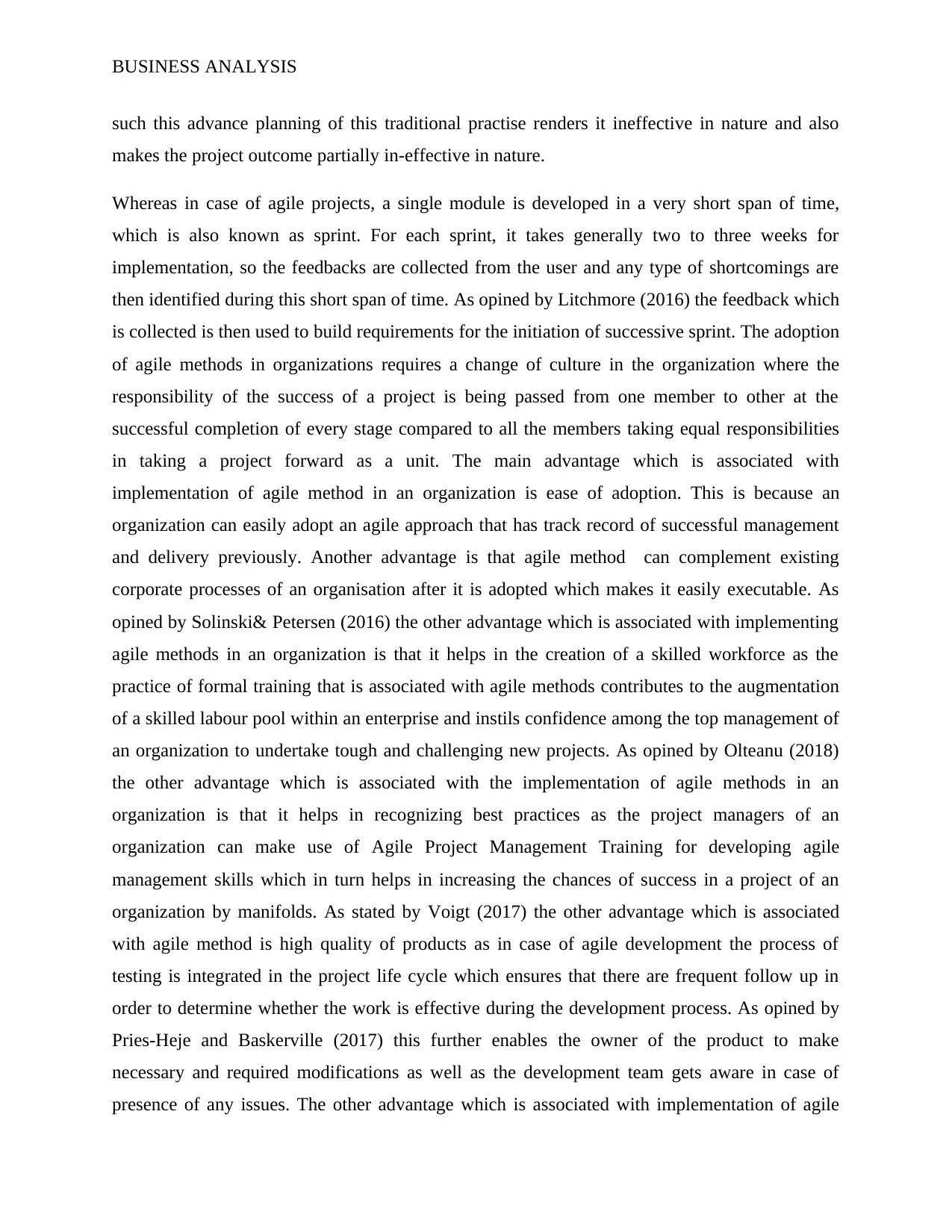
BUSINESS ANALYSIS
such this advance planning of this traditional practise renders it ineffective in nature and also
makes the project outcome partially in-effective in nature.
Whereas in case of agile projects, a single module is developed in a very short span of time,
which is also known as sprint. For each sprint, it takes generally two to three weeks for
implementation, so the feedbacks are collected from the user and any type of shortcomings are
then identified during this short span of time. As opined by Litchmore (2016) the feedback which
is collected is then used to build requirements for the initiation of successive sprint. The adoption
of agile methods in organizations requires a change of culture in the organization where the
responsibility of the success of a project is being passed from one member to other at the
successful completion of every stage compared to all the members taking equal responsibilities
in taking a project forward as a unit. The main advantage which is associated with
implementation of agile method in an organization is ease of adoption. This is because an
organization can easily adopt an agile approach that has track record of successful management
and delivery previously. Another advantage is that agile method can complement existing
corporate processes of an organisation after it is adopted which makes it easily executable. As
opined by Solinski& Petersen (2016) the other advantage which is associated with implementing
agile methods in an organization is that it helps in the creation of a skilled workforce as the
practice of formal training that is associated with agile methods contributes to the augmentation
of a skilled labour pool within an enterprise and instils confidence among the top management of
an organization to undertake tough and challenging new projects. As opined by Olteanu (2018)
the other advantage which is associated with the implementation of agile methods in an
organization is that it helps in recognizing best practices as the project managers of an
organization can make use of Agile Project Management Training for developing agile
management skills which in turn helps in increasing the chances of success in a project of an
organization by manifolds. As stated by Voigt (2017) the other advantage which is associated
with agile method is high quality of products as in case of agile development the process of
testing is integrated in the project life cycle which ensures that there are frequent follow up in
order to determine whether the work is effective during the development process. As opined by
Pries-Heje and Baskerville (2017) this further enables the owner of the product to make
necessary and required modifications as well as the development team gets aware in case of
presence of any issues. The other advantage which is associated with implementation of agile
such this advance planning of this traditional practise renders it ineffective in nature and also
makes the project outcome partially in-effective in nature.
Whereas in case of agile projects, a single module is developed in a very short span of time,
which is also known as sprint. For each sprint, it takes generally two to three weeks for
implementation, so the feedbacks are collected from the user and any type of shortcomings are
then identified during this short span of time. As opined by Litchmore (2016) the feedback which
is collected is then used to build requirements for the initiation of successive sprint. The adoption
of agile methods in organizations requires a change of culture in the organization where the
responsibility of the success of a project is being passed from one member to other at the
successful completion of every stage compared to all the members taking equal responsibilities
in taking a project forward as a unit. The main advantage which is associated with
implementation of agile method in an organization is ease of adoption. This is because an
organization can easily adopt an agile approach that has track record of successful management
and delivery previously. Another advantage is that agile method can complement existing
corporate processes of an organisation after it is adopted which makes it easily executable. As
opined by Solinski& Petersen (2016) the other advantage which is associated with implementing
agile methods in an organization is that it helps in the creation of a skilled workforce as the
practice of formal training that is associated with agile methods contributes to the augmentation
of a skilled labour pool within an enterprise and instils confidence among the top management of
an organization to undertake tough and challenging new projects. As opined by Olteanu (2018)
the other advantage which is associated with the implementation of agile methods in an
organization is that it helps in recognizing best practices as the project managers of an
organization can make use of Agile Project Management Training for developing agile
management skills which in turn helps in increasing the chances of success in a project of an
organization by manifolds. As stated by Voigt (2017) the other advantage which is associated
with agile method is high quality of products as in case of agile development the process of
testing is integrated in the project life cycle which ensures that there are frequent follow up in
order to determine whether the work is effective during the development process. As opined by
Pries-Heje and Baskerville (2017) this further enables the owner of the product to make
necessary and required modifications as well as the development team gets aware in case of
presence of any issues. The other advantage which is associated with implementation of agile
⊘ This is a preview!⊘
Do you want full access?
Subscribe today to unlock all pages.

Trusted by 1+ million students worldwide
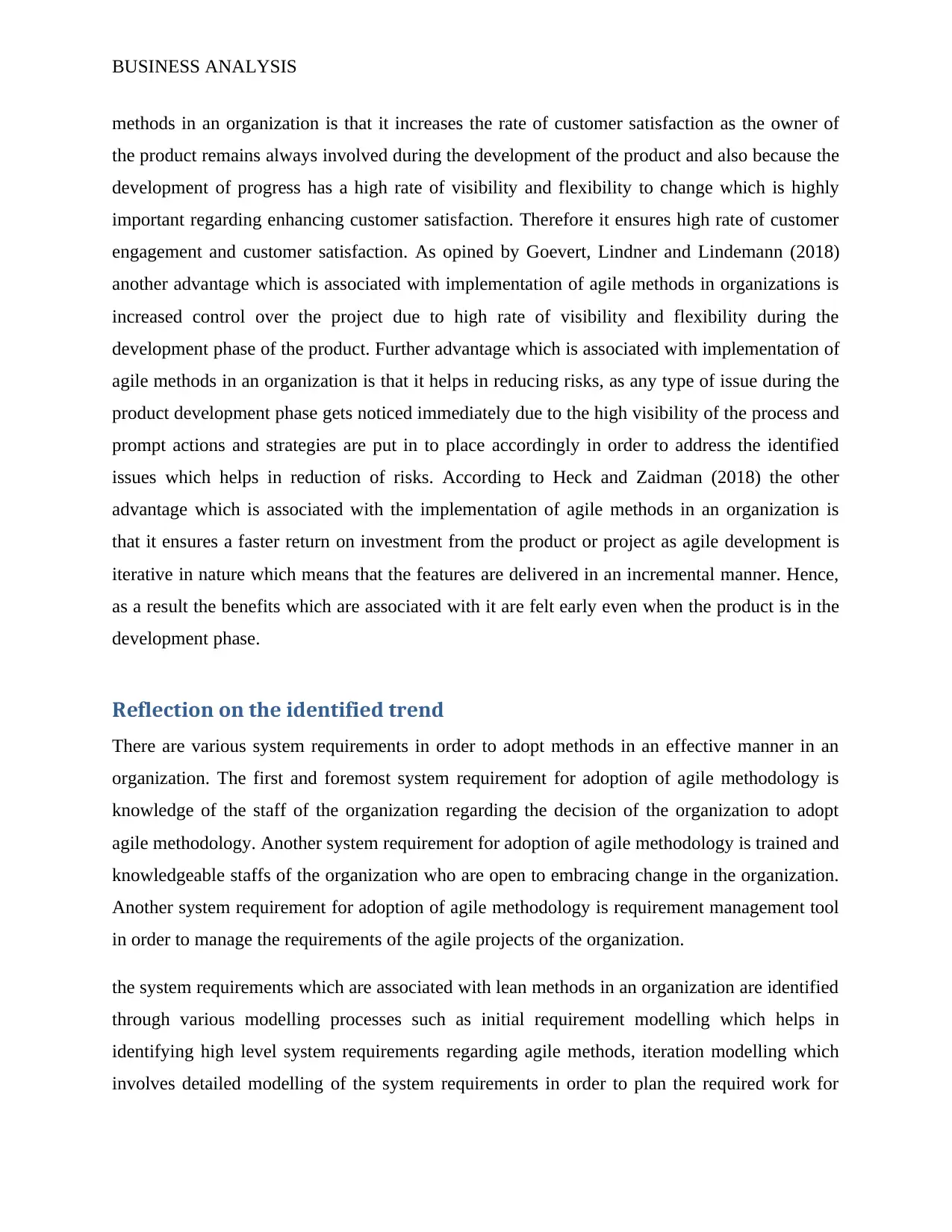
BUSINESS ANALYSIS
methods in an organization is that it increases the rate of customer satisfaction as the owner of
the product remains always involved during the development of the product and also because the
development of progress has a high rate of visibility and flexibility to change which is highly
important regarding enhancing customer satisfaction. Therefore it ensures high rate of customer
engagement and customer satisfaction. As opined by Goevert, Lindner and Lindemann (2018)
another advantage which is associated with implementation of agile methods in organizations is
increased control over the project due to high rate of visibility and flexibility during the
development phase of the product. Further advantage which is associated with implementation of
agile methods in an organization is that it helps in reducing risks, as any type of issue during the
product development phase gets noticed immediately due to the high visibility of the process and
prompt actions and strategies are put in to place accordingly in order to address the identified
issues which helps in reduction of risks. According to Heck and Zaidman (2018) the other
advantage which is associated with the implementation of agile methods in an organization is
that it ensures a faster return on investment from the product or project as agile development is
iterative in nature which means that the features are delivered in an incremental manner. Hence,
as a result the benefits which are associated with it are felt early even when the product is in the
development phase.
Reflection on the identified trend
There are various system requirements in order to adopt methods in an effective manner in an
organization. The first and foremost system requirement for adoption of agile methodology is
knowledge of the staff of the organization regarding the decision of the organization to adopt
agile methodology. Another system requirement for adoption of agile methodology is trained and
knowledgeable staffs of the organization who are open to embracing change in the organization.
Another system requirement for adoption of agile methodology is requirement management tool
in order to manage the requirements of the agile projects of the organization.
the system requirements which are associated with lean methods in an organization are identified
through various modelling processes such as initial requirement modelling which helps in
identifying high level system requirements regarding agile methods, iteration modelling which
involves detailed modelling of the system requirements in order to plan the required work for
methods in an organization is that it increases the rate of customer satisfaction as the owner of
the product remains always involved during the development of the product and also because the
development of progress has a high rate of visibility and flexibility to change which is highly
important regarding enhancing customer satisfaction. Therefore it ensures high rate of customer
engagement and customer satisfaction. As opined by Goevert, Lindner and Lindemann (2018)
another advantage which is associated with implementation of agile methods in organizations is
increased control over the project due to high rate of visibility and flexibility during the
development phase of the product. Further advantage which is associated with implementation of
agile methods in an organization is that it helps in reducing risks, as any type of issue during the
product development phase gets noticed immediately due to the high visibility of the process and
prompt actions and strategies are put in to place accordingly in order to address the identified
issues which helps in reduction of risks. According to Heck and Zaidman (2018) the other
advantage which is associated with the implementation of agile methods in an organization is
that it ensures a faster return on investment from the product or project as agile development is
iterative in nature which means that the features are delivered in an incremental manner. Hence,
as a result the benefits which are associated with it are felt early even when the product is in the
development phase.
Reflection on the identified trend
There are various system requirements in order to adopt methods in an effective manner in an
organization. The first and foremost system requirement for adoption of agile methodology is
knowledge of the staff of the organization regarding the decision of the organization to adopt
agile methodology. Another system requirement for adoption of agile methodology is trained and
knowledgeable staffs of the organization who are open to embracing change in the organization.
Another system requirement for adoption of agile methodology is requirement management tool
in order to manage the requirements of the agile projects of the organization.
the system requirements which are associated with lean methods in an organization are identified
through various modelling processes such as initial requirement modelling which helps in
identifying high level system requirements regarding agile methods, iteration modelling which
involves detailed modelling of the system requirements in order to plan the required work for
Paraphrase This Document
Need a fresh take? Get an instant paraphrase of this document with our AI Paraphraser
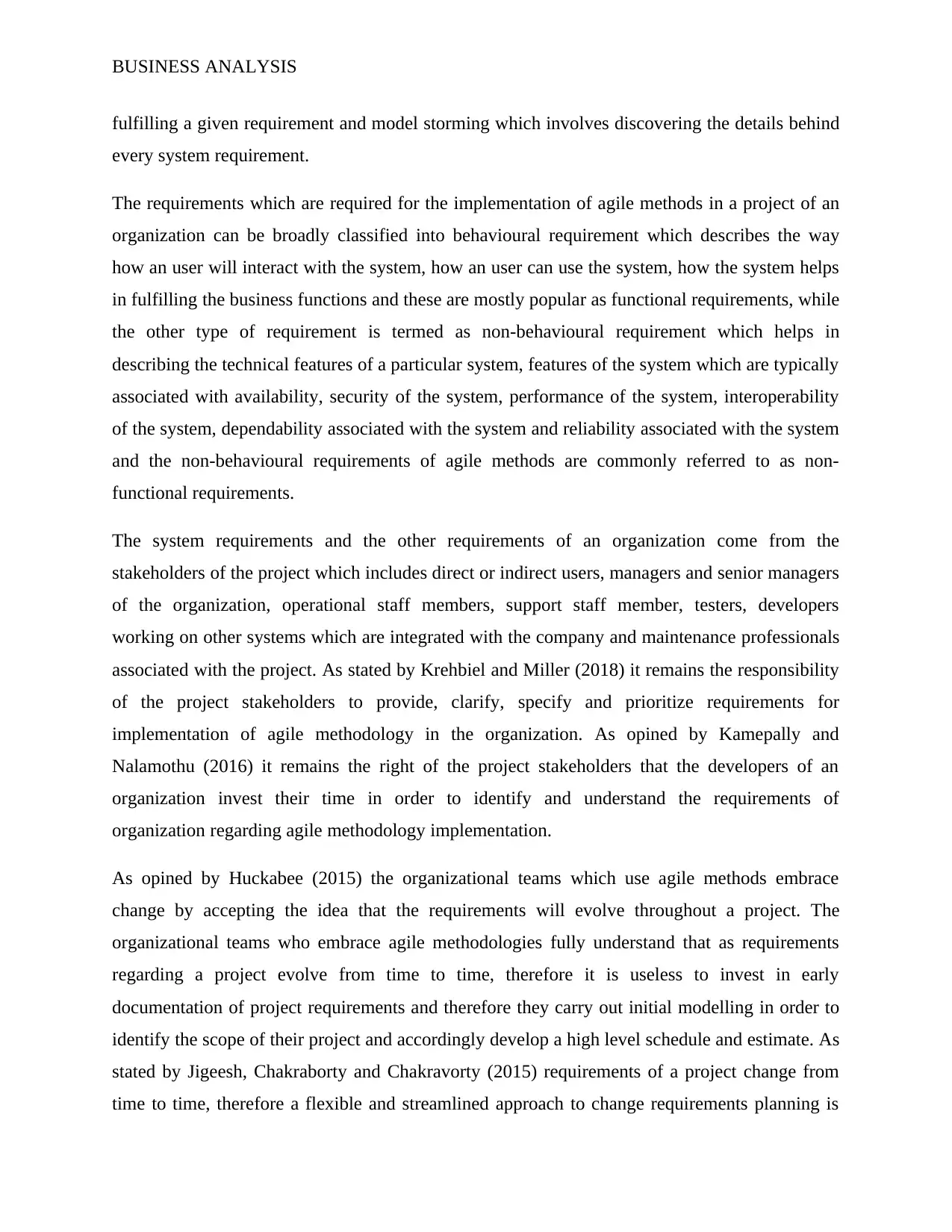
BUSINESS ANALYSIS
fulfilling a given requirement and model storming which involves discovering the details behind
every system requirement.
The requirements which are required for the implementation of agile methods in a project of an
organization can be broadly classified into behavioural requirement which describes the way
how an user will interact with the system, how an user can use the system, how the system helps
in fulfilling the business functions and these are mostly popular as functional requirements, while
the other type of requirement is termed as non-behavioural requirement which helps in
describing the technical features of a particular system, features of the system which are typically
associated with availability, security of the system, performance of the system, interoperability
of the system, dependability associated with the system and reliability associated with the system
and the non-behavioural requirements of agile methods are commonly referred to as non-
functional requirements.
The system requirements and the other requirements of an organization come from the
stakeholders of the project which includes direct or indirect users, managers and senior managers
of the organization, operational staff members, support staff member, testers, developers
working on other systems which are integrated with the company and maintenance professionals
associated with the project. As stated by Krehbiel and Miller (2018) it remains the responsibility
of the project stakeholders to provide, clarify, specify and prioritize requirements for
implementation of agile methodology in the organization. As opined by Kamepally and
Nalamothu (2016) it remains the right of the project stakeholders that the developers of an
organization invest their time in order to identify and understand the requirements of
organization regarding agile methodology implementation.
As opined by Huckabee (2015) the organizational teams which use agile methods embrace
change by accepting the idea that the requirements will evolve throughout a project. The
organizational teams who embrace agile methodologies fully understand that as requirements
regarding a project evolve from time to time, therefore it is useless to invest in early
documentation of project requirements and therefore they carry out initial modelling in order to
identify the scope of their project and accordingly develop a high level schedule and estimate. As
stated by Jigeesh, Chakraborty and Chakravorty (2015) requirements of a project change from
time to time, therefore a flexible and streamlined approach to change requirements planning is
fulfilling a given requirement and model storming which involves discovering the details behind
every system requirement.
The requirements which are required for the implementation of agile methods in a project of an
organization can be broadly classified into behavioural requirement which describes the way
how an user will interact with the system, how an user can use the system, how the system helps
in fulfilling the business functions and these are mostly popular as functional requirements, while
the other type of requirement is termed as non-behavioural requirement which helps in
describing the technical features of a particular system, features of the system which are typically
associated with availability, security of the system, performance of the system, interoperability
of the system, dependability associated with the system and reliability associated with the system
and the non-behavioural requirements of agile methods are commonly referred to as non-
functional requirements.
The system requirements and the other requirements of an organization come from the
stakeholders of the project which includes direct or indirect users, managers and senior managers
of the organization, operational staff members, support staff member, testers, developers
working on other systems which are integrated with the company and maintenance professionals
associated with the project. As stated by Krehbiel and Miller (2018) it remains the responsibility
of the project stakeholders to provide, clarify, specify and prioritize requirements for
implementation of agile methodology in the organization. As opined by Kamepally and
Nalamothu (2016) it remains the right of the project stakeholders that the developers of an
organization invest their time in order to identify and understand the requirements of
organization regarding agile methodology implementation.
As opined by Huckabee (2015) the organizational teams which use agile methods embrace
change by accepting the idea that the requirements will evolve throughout a project. The
organizational teams who embrace agile methodologies fully understand that as requirements
regarding a project evolve from time to time, therefore it is useless to invest in early
documentation of project requirements and therefore they carry out initial modelling in order to
identify the scope of their project and accordingly develop a high level schedule and estimate. As
stated by Jigeesh, Chakraborty and Chakravorty (2015) requirements of a project change from
time to time, therefore a flexible and streamlined approach to change requirements planning is
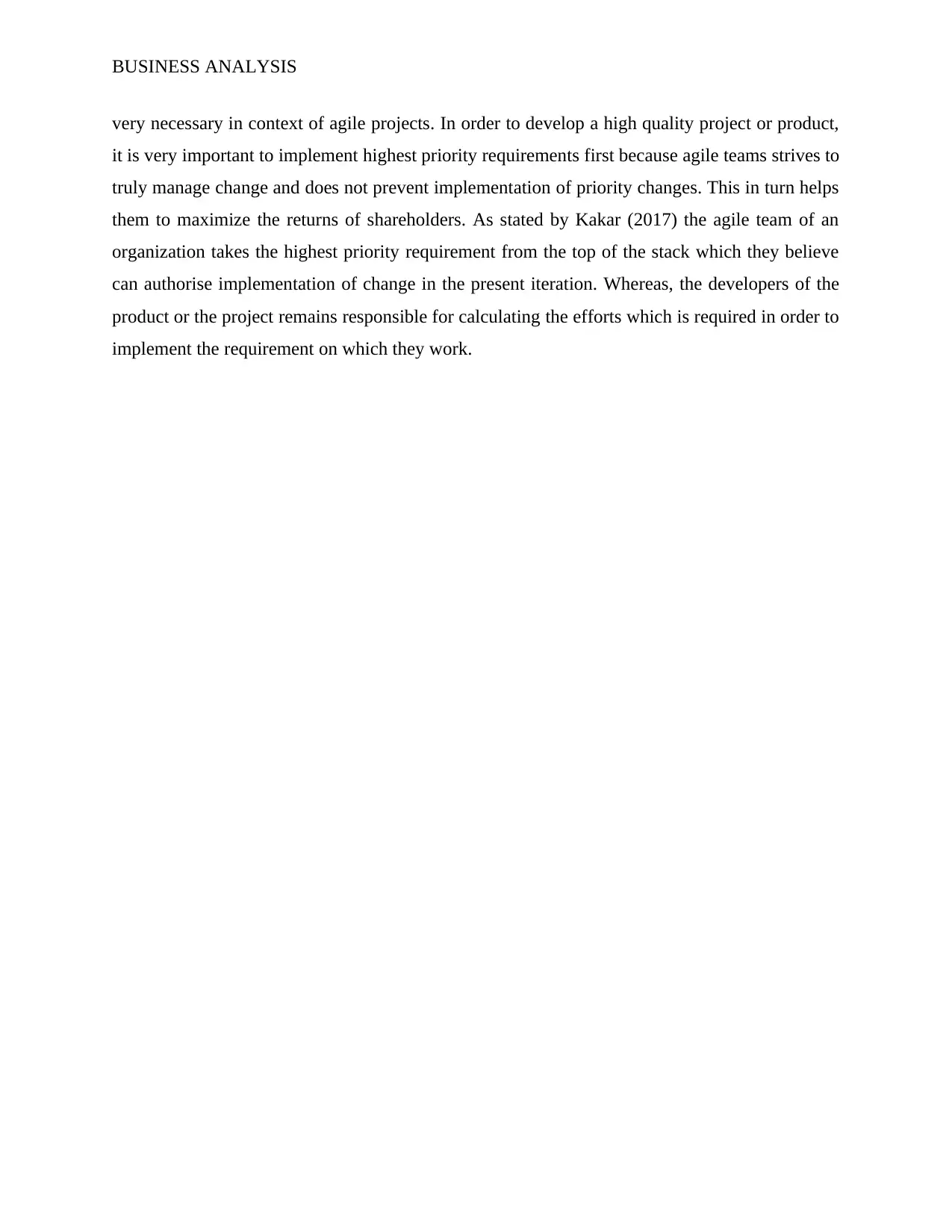
BUSINESS ANALYSIS
very necessary in context of agile projects. In order to develop a high quality project or product,
it is very important to implement highest priority requirements first because agile teams strives to
truly manage change and does not prevent implementation of priority changes. This in turn helps
them to maximize the returns of shareholders. As stated by Kakar (2017) the agile team of an
organization takes the highest priority requirement from the top of the stack which they believe
can authorise implementation of change in the present iteration. Whereas, the developers of the
product or the project remains responsible for calculating the efforts which is required in order to
implement the requirement on which they work.
very necessary in context of agile projects. In order to develop a high quality project or product,
it is very important to implement highest priority requirements first because agile teams strives to
truly manage change and does not prevent implementation of priority changes. This in turn helps
them to maximize the returns of shareholders. As stated by Kakar (2017) the agile team of an
organization takes the highest priority requirement from the top of the stack which they believe
can authorise implementation of change in the present iteration. Whereas, the developers of the
product or the project remains responsible for calculating the efforts which is required in order to
implement the requirement on which they work.
⊘ This is a preview!⊘
Do you want full access?
Subscribe today to unlock all pages.

Trusted by 1+ million students worldwide
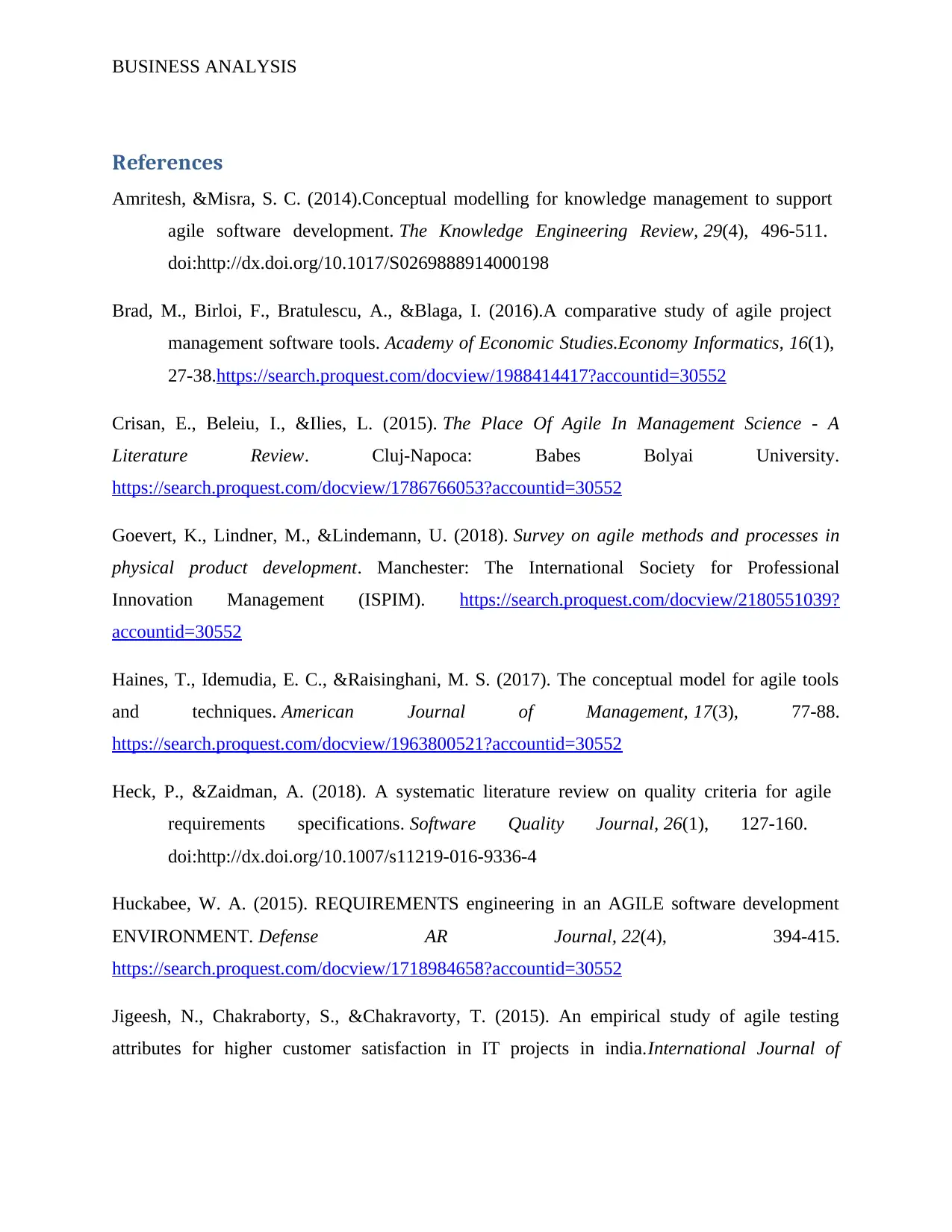
BUSINESS ANALYSIS
References
Amritesh, &Misra, S. C. (2014).Conceptual modelling for knowledge management to support
agile software development. The Knowledge Engineering Review, 29(4), 496-511.
doi:http://dx.doi.org/10.1017/S0269888914000198
Brad, M., Birloi, F., Bratulescu, A., &Blaga, I. (2016).A comparative study of agile project
management software tools. Academy of Economic Studies.Economy Informatics, 16(1),
27-38.https://search.proquest.com/docview/1988414417?accountid=30552
Crisan, E., Beleiu, I., &Ilies, L. (2015). The Place Of Agile In Management Science - A
Literature Review. Cluj-Napoca: Babes Bolyai University.
https://search.proquest.com/docview/1786766053?accountid=30552
Goevert, K., Lindner, M., &Lindemann, U. (2018). Survey on agile methods and processes in
physical product development. Manchester: The International Society for Professional
Innovation Management (ISPIM). https://search.proquest.com/docview/2180551039?
accountid=30552
Haines, T., Idemudia, E. C., &Raisinghani, M. S. (2017). The conceptual model for agile tools
and techniques. American Journal of Management, 17(3), 77-88.
https://search.proquest.com/docview/1963800521?accountid=30552
Heck, P., &Zaidman, A. (2018). A systematic literature review on quality criteria for agile
requirements specifications. Software Quality Journal, 26(1), 127-160.
doi:http://dx.doi.org/10.1007/s11219-016-9336-4
Huckabee, W. A. (2015). REQUIREMENTS engineering in an AGILE software development
ENVIRONMENT. Defense AR Journal, 22(4), 394-415.
https://search.proquest.com/docview/1718984658?accountid=30552
Jigeesh, N., Chakraborty, S., &Chakravorty, T. (2015). An empirical study of agile testing
attributes for higher customer satisfaction in IT projects in india.International Journal of
References
Amritesh, &Misra, S. C. (2014).Conceptual modelling for knowledge management to support
agile software development. The Knowledge Engineering Review, 29(4), 496-511.
doi:http://dx.doi.org/10.1017/S0269888914000198
Brad, M., Birloi, F., Bratulescu, A., &Blaga, I. (2016).A comparative study of agile project
management software tools. Academy of Economic Studies.Economy Informatics, 16(1),
27-38.https://search.proquest.com/docview/1988414417?accountid=30552
Crisan, E., Beleiu, I., &Ilies, L. (2015). The Place Of Agile In Management Science - A
Literature Review. Cluj-Napoca: Babes Bolyai University.
https://search.proquest.com/docview/1786766053?accountid=30552
Goevert, K., Lindner, M., &Lindemann, U. (2018). Survey on agile methods and processes in
physical product development. Manchester: The International Society for Professional
Innovation Management (ISPIM). https://search.proquest.com/docview/2180551039?
accountid=30552
Haines, T., Idemudia, E. C., &Raisinghani, M. S. (2017). The conceptual model for agile tools
and techniques. American Journal of Management, 17(3), 77-88.
https://search.proquest.com/docview/1963800521?accountid=30552
Heck, P., &Zaidman, A. (2018). A systematic literature review on quality criteria for agile
requirements specifications. Software Quality Journal, 26(1), 127-160.
doi:http://dx.doi.org/10.1007/s11219-016-9336-4
Huckabee, W. A. (2015). REQUIREMENTS engineering in an AGILE software development
ENVIRONMENT. Defense AR Journal, 22(4), 394-415.
https://search.proquest.com/docview/1718984658?accountid=30552
Jigeesh, N., Chakraborty, S., &Chakravorty, T. (2015). An empirical study of agile testing
attributes for higher customer satisfaction in IT projects in india.International Journal of
Paraphrase This Document
Need a fresh take? Get an instant paraphrase of this document with our AI Paraphraser
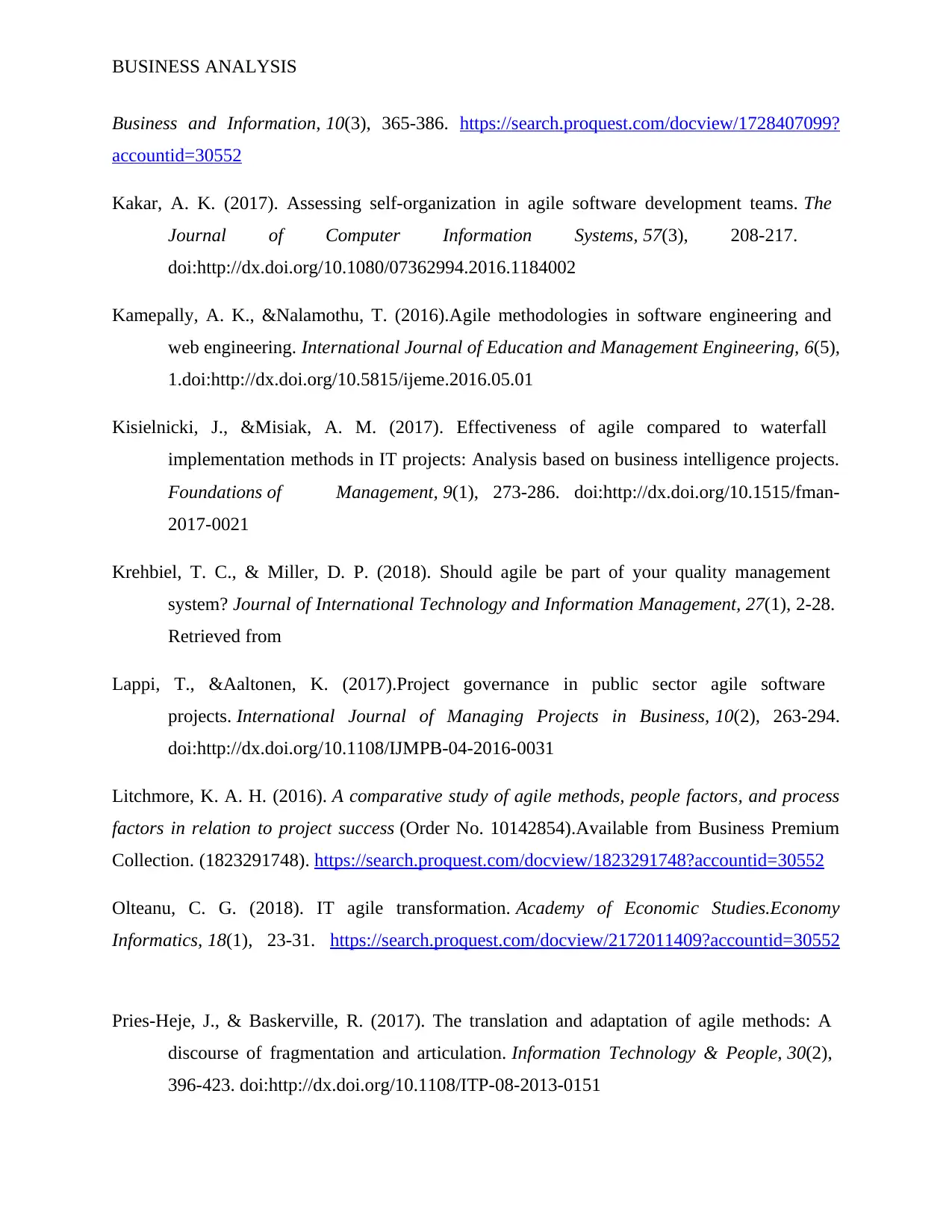
BUSINESS ANALYSIS
Business and Information, 10(3), 365-386. https://search.proquest.com/docview/1728407099?
accountid=30552
Kakar, A. K. (2017). Assessing self-organization in agile software development teams. The
Journal of Computer Information Systems, 57(3), 208-217.
doi:http://dx.doi.org/10.1080/07362994.2016.1184002
Kamepally, A. K., &Nalamothu, T. (2016).Agile methodologies in software engineering and
web engineering. International Journal of Education and Management Engineering, 6(5),
1.doi:http://dx.doi.org/10.5815/ijeme.2016.05.01
Kisielnicki, J., &Misiak, A. M. (2017). Effectiveness of agile compared to waterfall
implementation methods in IT projects: Analysis based on business intelligence projects.
Foundations of Management, 9(1), 273-286. doi:http://dx.doi.org/10.1515/fman-
2017-0021
Krehbiel, T. C., & Miller, D. P. (2018). Should agile be part of your quality management
system? Journal of International Technology and Information Management, 27(1), 2-28.
Retrieved from
Lappi, T., &Aaltonen, K. (2017).Project governance in public sector agile software
projects. International Journal of Managing Projects in Business, 10(2), 263-294.
doi:http://dx.doi.org/10.1108/IJMPB-04-2016-0031
Litchmore, K. A. H. (2016). A comparative study of agile methods, people factors, and process
factors in relation to project success (Order No. 10142854).Available from Business Premium
Collection. (1823291748). https://search.proquest.com/docview/1823291748?accountid=30552
Olteanu, C. G. (2018). IT agile transformation. Academy of Economic Studies.Economy
Informatics, 18(1), 23-31. https://search.proquest.com/docview/2172011409?accountid=30552
Pries-Heje, J., & Baskerville, R. (2017). The translation and adaptation of agile methods: A
discourse of fragmentation and articulation. Information Technology & People, 30(2),
396-423. doi:http://dx.doi.org/10.1108/ITP-08-2013-0151
Business and Information, 10(3), 365-386. https://search.proquest.com/docview/1728407099?
accountid=30552
Kakar, A. K. (2017). Assessing self-organization in agile software development teams. The
Journal of Computer Information Systems, 57(3), 208-217.
doi:http://dx.doi.org/10.1080/07362994.2016.1184002
Kamepally, A. K., &Nalamothu, T. (2016).Agile methodologies in software engineering and
web engineering. International Journal of Education and Management Engineering, 6(5),
1.doi:http://dx.doi.org/10.5815/ijeme.2016.05.01
Kisielnicki, J., &Misiak, A. M. (2017). Effectiveness of agile compared to waterfall
implementation methods in IT projects: Analysis based on business intelligence projects.
Foundations of Management, 9(1), 273-286. doi:http://dx.doi.org/10.1515/fman-
2017-0021
Krehbiel, T. C., & Miller, D. P. (2018). Should agile be part of your quality management
system? Journal of International Technology and Information Management, 27(1), 2-28.
Retrieved from
Lappi, T., &Aaltonen, K. (2017).Project governance in public sector agile software
projects. International Journal of Managing Projects in Business, 10(2), 263-294.
doi:http://dx.doi.org/10.1108/IJMPB-04-2016-0031
Litchmore, K. A. H. (2016). A comparative study of agile methods, people factors, and process
factors in relation to project success (Order No. 10142854).Available from Business Premium
Collection. (1823291748). https://search.proquest.com/docview/1823291748?accountid=30552
Olteanu, C. G. (2018). IT agile transformation. Academy of Economic Studies.Economy
Informatics, 18(1), 23-31. https://search.proquest.com/docview/2172011409?accountid=30552
Pries-Heje, J., & Baskerville, R. (2017). The translation and adaptation of agile methods: A
discourse of fragmentation and articulation. Information Technology & People, 30(2),
396-423. doi:http://dx.doi.org/10.1108/ITP-08-2013-0151
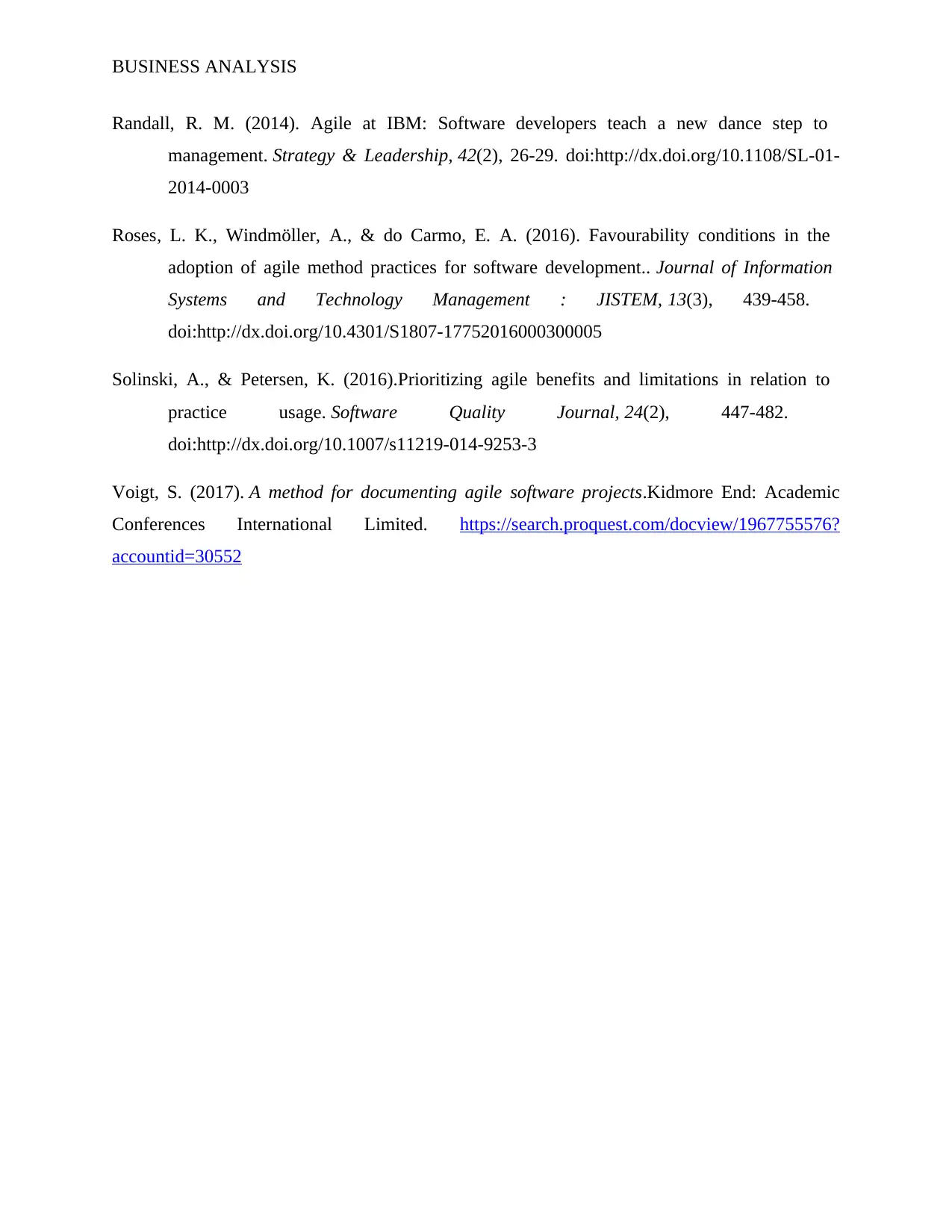
BUSINESS ANALYSIS
Randall, R. M. (2014). Agile at IBM: Software developers teach a new dance step to
management. Strategy & Leadership, 42(2), 26-29. doi:http://dx.doi.org/10.1108/SL-01-
2014-0003
Roses, L. K., Windmöller, A., & do Carmo, E. A. (2016). Favourability conditions in the
adoption of agile method practices for software development.. Journal of Information
Systems and Technology Management : JISTEM, 13(3), 439-458.
doi:http://dx.doi.org/10.4301/S1807-17752016000300005
Solinski, A., & Petersen, K. (2016).Prioritizing agile benefits and limitations in relation to
practice usage. Software Quality Journal, 24(2), 447-482.
doi:http://dx.doi.org/10.1007/s11219-014-9253-3
Voigt, S. (2017). A method for documenting agile software projects.Kidmore End: Academic
Conferences International Limited. https://search.proquest.com/docview/1967755576?
accountid=30552
Randall, R. M. (2014). Agile at IBM: Software developers teach a new dance step to
management. Strategy & Leadership, 42(2), 26-29. doi:http://dx.doi.org/10.1108/SL-01-
2014-0003
Roses, L. K., Windmöller, A., & do Carmo, E. A. (2016). Favourability conditions in the
adoption of agile method practices for software development.. Journal of Information
Systems and Technology Management : JISTEM, 13(3), 439-458.
doi:http://dx.doi.org/10.4301/S1807-17752016000300005
Solinski, A., & Petersen, K. (2016).Prioritizing agile benefits and limitations in relation to
practice usage. Software Quality Journal, 24(2), 447-482.
doi:http://dx.doi.org/10.1007/s11219-014-9253-3
Voigt, S. (2017). A method for documenting agile software projects.Kidmore End: Academic
Conferences International Limited. https://search.proquest.com/docview/1967755576?
accountid=30552
⊘ This is a preview!⊘
Do you want full access?
Subscribe today to unlock all pages.

Trusted by 1+ million students worldwide
1 out of 12
Related Documents
Your All-in-One AI-Powered Toolkit for Academic Success.
+13062052269
info@desklib.com
Available 24*7 on WhatsApp / Email
![[object Object]](/_next/static/media/star-bottom.7253800d.svg)
Unlock your academic potential
Copyright © 2020–2025 A2Z Services. All Rights Reserved. Developed and managed by ZUCOL.



